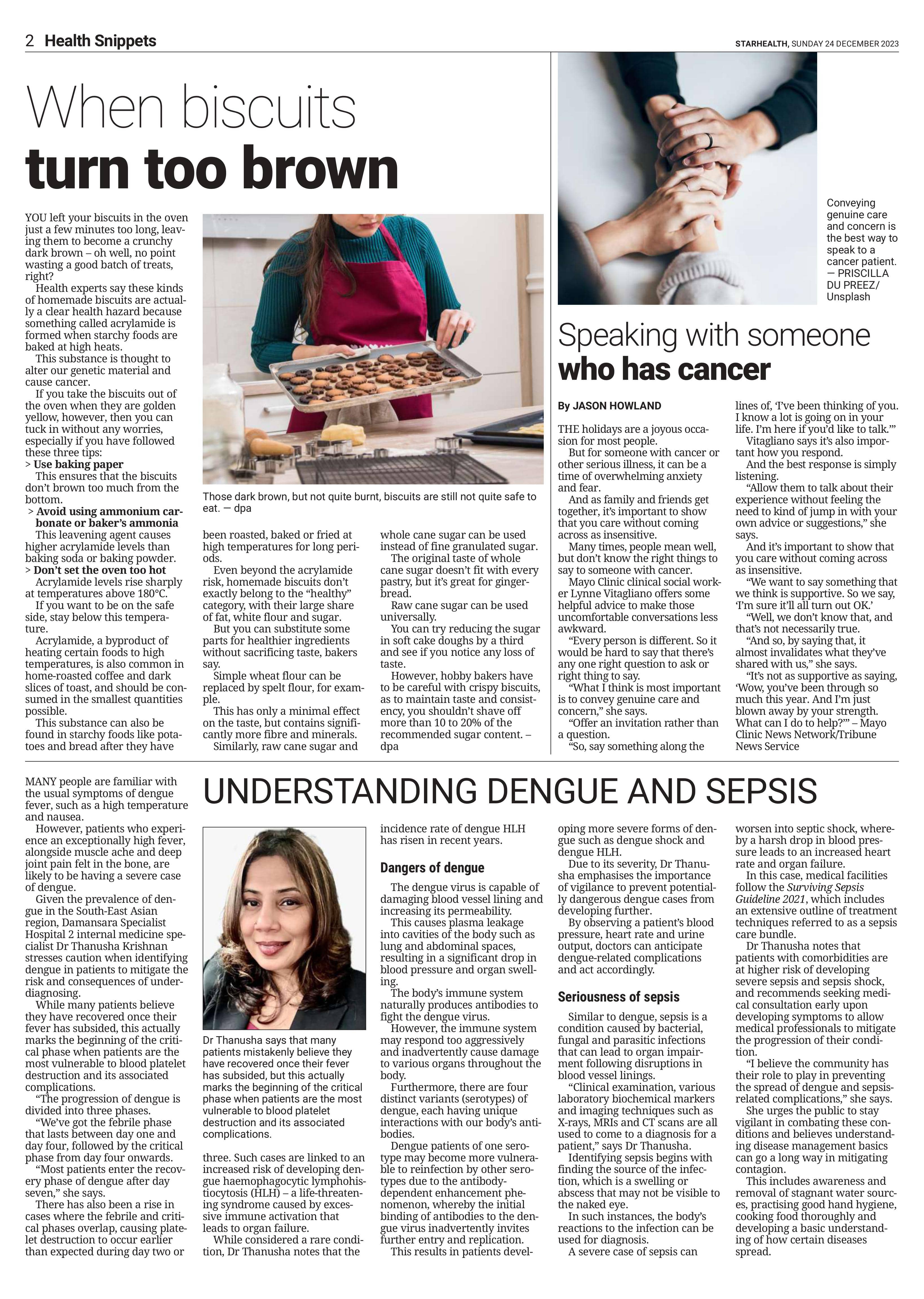Understanding Dengue and Sepsis

UNDERSTANDING DENGUE AND SEPSIS
MANY people are familiar with the usual symptoms of dengue fever, such as a high temperature and nausea. However, patients who experience an exceptionally high fever, alongside muscle aches and deep joint pain felt in the bone, are likely to be having a severe case of dengue.
Given the prevalence of dengue in the South-East Asian region, Damansara Specialist Hospital 2 internal medicine specialist Dr Thanusha Krishnan stresses caution when identifying dengue in patients to mitigate the risk and consequences of under-diagnosing. While many patients believe they have recovered once their fever has subsided, this actually marks the beginning of the critical phase when patients are the most vulnerable to blood platelet destruction and its associated complications.
“The progression of dengue is divided into three phases. “We’ve got the febrile phase that lasts between day one and day four, followed by the critical phase from day four onwards.
“Most patients enter the recovery phase of dengue after day seven,” she says. There has also been a rise in cases where the febrile and critical phases overlap, causing platelet destruction to occur earlier than expected during day two or three. Such cases are linked to an increased risk of developing dengue haemophagocytic lymphohistiocytosis (HLH) – a life-threatening syndrome caused by excessive immune activation that leads to organ failure.
While considered a rare condition, Dr Thanusha notes that the incidence rate of dengue HLH has risen in recent years.
Dangers of dengue
The dengue virus is capable of damaging blood vessel lining and increasing its permeability.
This causes plasma leakage into cavities of the body such as lung and abdominal spaces, resulting in a significant drop in blood pressure and organ swelling. The body’s immune system naturally produces antibodies to fight the dengue virus. However, the immune system may respond too aggressively and inadvertently cause damage to various organs throughout the body.
Furthermore, there are four distinct variants (serotypes) of dengue, each having unique interactions with our body’s anti-bodies. Dengue patients of one serotype may become more vulnerable to reinfection by other serotypes due to the antibody-dependent enhancement phenomenon, whereby the initial binding of antibodies to the dengue virus inadvertently invites further entry and replication.
This results in patients developing more severe forms of dengue such as dengue shock and dengue HLH. Due to its severity, Dr Thanusha emphasises the importance of vigilance to prevent potentially dangerous dengue cases from developing further. By observing a patient’s blood pressure, heart rate and urine output, doctors can anticipate dengue-related complications and act accordingly.
Seriousness of sepsis
Similar to dengue, sepsis is a condition caused by bacterial, fungal, and parasitic infections that can lead to organ impairment following disruptions in blood vessel linings. “Clinical examination, various laboratory biochemical markers and imaging techniques such as X-rays, MRIs and CT scans are all used to come to a diagnosis for a patient,” says Dr Thanusha.
Identifying sepsis begins with finding the source of the infection, which is a swelling or abscess that may not be visible to the naked eye. In such instances, the body’s reactions to the infection can be used for diagnosis. A severe case of sepsis can worsen into septic shock, whereby a harsh drop in blood pressure leads to an increased heart rate and organ failure. In this case, medical facilities follow the Surviving Sepsis Guideline 2021, which includes an extensive outline of treatment techniques referred to as a sepsis care bundle. Dr Thanusha notes that patients with comorbidities are at higher risk of developing severe sepsis and sepsis shock, and recommends seeking medical consultation early upon developing symptoms to allow medical professionals to mitigate the progression of their condition.
“I believe the community has their role to play in preventing the spread of dengue and sepsis-related complications,” she says. She urges the public to stay vigilant in combating these conditions and believes understanding disease management basics can go a long way in mitigating contagion. This includes awareness and removal of stagnant water sources, practising good hand hygiene, cooking food thoroughly and developing a basic understanding of how certain diseases spread.
For more information, contact 03-7717 3000.




 Promotion
Promotion
 Find Doctor
Find Doctor


